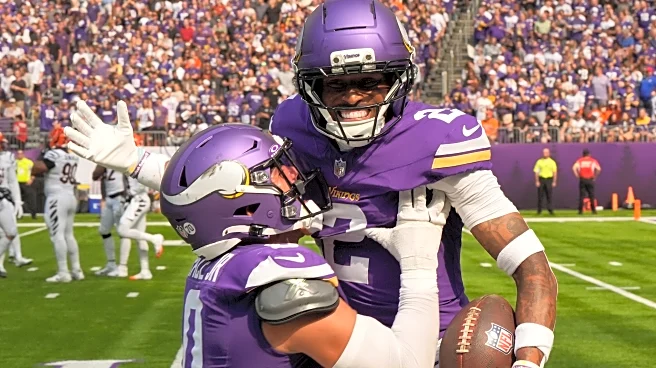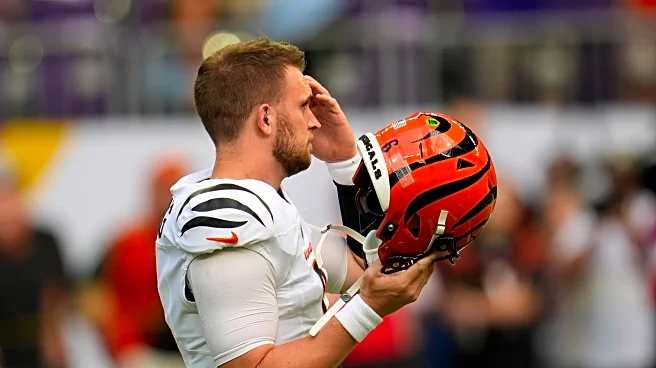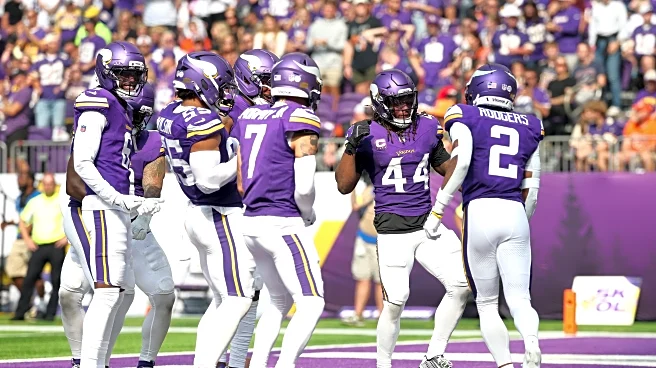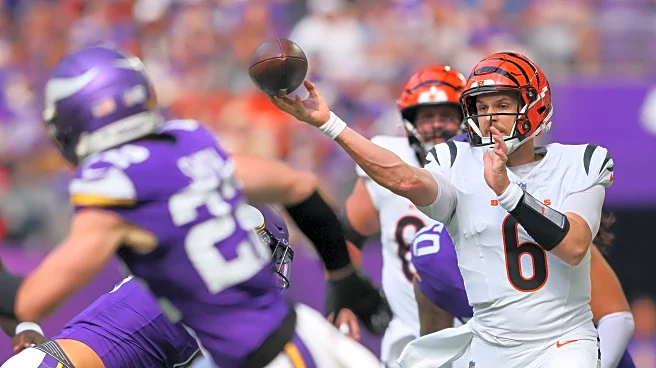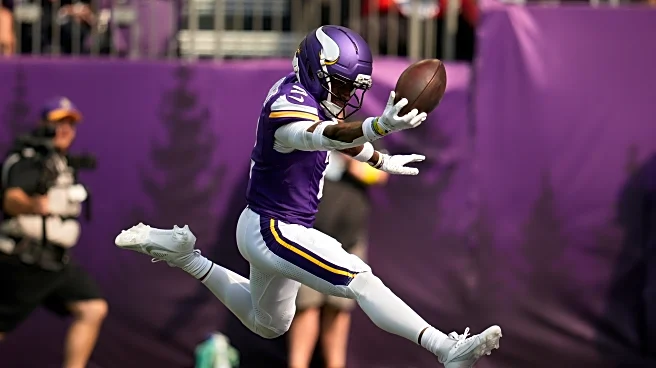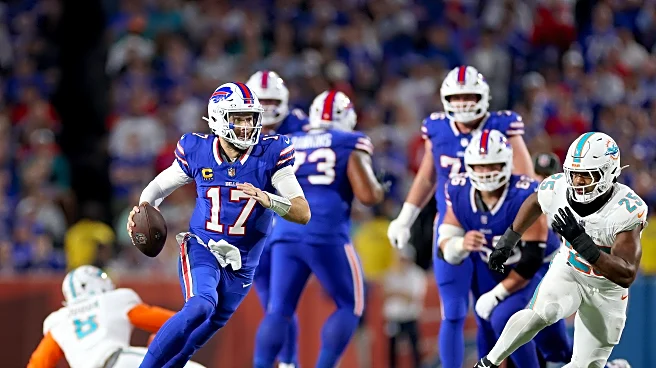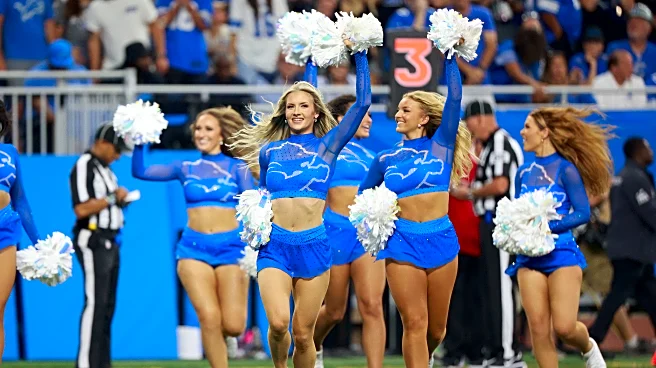If Jake Browning was looking for a Cinderella story in his return to Minnesota, he was in for a rude awakening. While he was the headlining player because of his position, the Bengals’ implosion on Sunday
wasn’t solely on his shoulders.
Here are the facets that were the good, the bad and the ugly on Sunday with the Bengals against the Vikings.
The Good
Myles Murphy — flashes when it mattered
Even in a game mostly to forget, Myles Murphy made a few plays that at least hinted at his upside. He logged a half‑sack (in combination) and had a heads-up chase-down on Carson Wentz, containing him for just a one-yard gain on a scramble. That kind of hustle play is the kind of effort you want from your edge defenders even when the game is slipping away.
Kris Jenkins, Jr. — showing some fight
Jenkins, a second-year interior lineman, had his moments. He recorded at least 1.5 sacks in the first half (per game narrative) against Minnesota’s line, which is not trivial. In a game where pass rush was otherwise largely stifled, his ability to generate pressure was one of the few positive signs for Cincinnati’s defensive front.
Evan McPherson — redeeming a rough ’24
With the Bengals starved for offense, McPherson provided one bright spot. He drilled a 45‑yard field goal with about five minutes left in the second quarter to scratch the scoreboard and give Cincinnati their first points. For a kicker, making the routine still matters — and after a shaky 2024 campaign, that was at least a modest step in the right direction.
The Bad
Interior offensive line — the soft spot exposed
If there was a weakest link in this game, it was the Bengals’ interior offensive line. Browning faced consistent pressure up the middle, and both Ted Karras and Dalton Risner struggled when matched up with Jonathan Allen and Javon Hargrave. The rookie Dylan Fairchild compounded the issue with a critical holding penalty on a drive early in the second quarter that wiped out a first down — one of those self-inflicted wounds that magnified an already rough day.
Worse still, the running game never got going. Facing a Brian Flores defense, the Bengals needed to keep things honest on the ground; instead, familiar failings reemerged. The line’s inability to create creases or sustain blocks forced the offense into long third downs and predictable passing situations.
Jake Browning — overmatched and error-prone
It may be harsh to lay the entire blame on Browning — the supporting cast was crumbling around him — but he had a disastrous outing. His stat line: 19-of-27 for 140 yards, 1 TD, 2 INTs per the box score.
He started the turnover spiral with a terrible read that resulted in an 87-yard pick-six to Isaiah Rodgers, after a tipped ball. Later in the first half, after working his way into Minnesota territory, a pass to Noah Fant was jarred loose by Rodgers, who scooped it and returned it 66 yards for another defensive score.
Browning threw another interception in the second half. On top of that, he fumbled a few times (or was part of fumble‑chain reactions) when the run game broke down, and he tried to do more than he should. The result: turnovers, short fields for Minnesota, and a game that slipped out of reach far too early.
Offensive staff (Taylor, Pitcher, Peters) — no answers, little adaptability
You can’t absolve the coaches in a collapse like this. The offense looked overmatched for large stretches, and they showed very little capacity to adjust. Without Joe Burrow, optimism was that Browning — formerly with the club — might recapture flashes of past form. Instead, the game plan repeatedly put Browning in no-win situations.
The staggering number of errors, the inability to protect, and the predictable play-calling all rest at least in part on scheme, preparation, and in-game adjustment. For Zac Taylor, suffering the worst loss in franchise history (by margin) is a dark mark. Questions will linger about whether this staff is capable of reliably functioning without a true elite QB in the mix.
Turnovers — from stars and role players alike
This wasn’t just a “bad day” for the backups; it was a collective breakdown. Four turnovers occurred in the first half alone, with two of them returned for touchdowns.
- Browning’s interception/pick-six to Rodgers
- Fant’s fumble forced and returned for a TD by Rodgers
- Ja’Marr Chase had a fumble (or had the ball punched out) after a catch, trying to make something happen
- Samaje Perine fumbled on the next possession
The Bengals had five total turnovers in the game, losing three of them.
It’s stunning how many veterans and key players contributed to that turnover pile — an indictment of focus, ball security, and execution.
Al Golden / the defense — worn down by situational burden
It’s unfair to expect defense to be flawless behind that kind of offensive implosion, but credit must be given where due. The defense did force some three‑and-outs early, and the Bengals ran five such in total.
But from the opening drive — Minnesota marched 64 yards in just over two minutes to score. The defense (and special teams) were repeatedly pinned by short fields, turnovers, and penalties. As the margin widened, the unit was forced into desperation modes, and Minnesota took advantage with Jordan Mason’s 116 rushing yards and two touchdowns.
In short, the defense was overworked, and without offensive support, it couldn’t carry the game.
Fan base & atmosphere — optimism meets harsh reality
The Bengals faithful have been through the ups and downs, and many were hanging onto hope that Browning could recapture something after the Burrow injury. But this Week 3 showing is likely to prompt a recalibration of expectations. This was not just a bad day — it was one of the most lopsided losses in team history.
For longtime fans, it had shades of the 1990s — squandered opportunity, collapse, and helplessness watching. Getting through this kind of blow requires mental resilience, and the front office, coaches, and players all must answer.
The Ugly
Historic margins and one of the worst-ever losses
This wasn’t just a bad day — the Bengals crossed into unprecedented territory. The final margin, 48–10, is the largest in franchise history (a 38-point loss).
At one point, Cincinnati trailed by 45 points (48–3) late in the third quarter — the biggest deficit they have ever faced in a game. Minnesota’s defense turned 31 points off Bengals turnovers — a staggering conversion rate. Pretty much enough said here.
Isaiah Rodgers, especially, turned the game into a personal highlight reel. In doing so, he entered the record books: two defensive touchdowns (87-yard pick-six, 66-yard fumble return) and two forced fumbles in a single game — something no one else has done in NFL history.
Momentum death spiral — compounding damage
Because the mistakes were so severe and so early, there was never a chance to mount any coherent comeback. The Bengals, down 14–0 early, saw everything get worse from there: short fields, turnovers, penalties, and defensive breakdowns. The halftime margin had ballooned, in part thanks to a 62-yard Will Reichard field goal as time expired in the half — the longest in Vikings history.
Once the game slipped away, the Bengals’ lone touchdown in the fourth quarter (a 4-yard pass from Browning to Drew Sample) was more garbage-time consolation than meaningful rally.
Psychological toll and outlook damage
Blowouts leave scars beyond the box score. For a team already in flux — losing a franchise QB, relying on backups — this performance provides no confidence boost. The coaches, players, and fans need to regroup quickly, because there’s no luxury in waiting around.
If this game teaches anything, it’s that talent, effort, and discipline all must be above reproach when you’re not operating with an elite passer. That the Bengals stumbled in all three dimensions makes this result far uglier than the score suggests.
Aftermath & Looking Ahead
- Stat recap & historical footnotes
- Browning: 19-of-27, 140 yards, 1 TD, 2 INTs
- Bengals rushing: just 53 yards on 21 carries
- Isaiah Rodgers: historic 87-yard pick-six and a 66-yard fumble return, coupled with two forced fumbles
- Jordan Mason: 116 rushing yards and two touchdowns
- Worst-ever margin and deficit marks for Cincinnati
- What must change
- The interior offensive line must improve or risk constant collapse. Whether through coaching, scheme tweaks, or personnel changes, that group is a limiting factor.
- Ball security and decision-making must become non-negotiables. Turnovers kill comebacks, and this game is proof.
- Offensive play-calling and game-plan flexibility must be upgraded so that Browning (or whoever is under center) is not asked to carry impossible weight.
- The defense needs help — not just from schemes but from offense doing less damage so that the unit isn’t set in extreme disadvantage repeatedly.
- A long road ahead
This game does not doom the season on its own, but it absolutely demands a response. The Bengals backup unit, especially offensively, was unprepared for a monster opponent under pressure. If they can’t correct course soon, the remainder of the schedule will chew them up.
In sum: Minnesota made the Bengals look small, collectively. A few bright spots (Murphy, Jenkins, McPherson) don’t excuse an afternoon of abject collapse. The “Good” existed — but the “Bad” and “Ugly” completely overwhelmed it.

